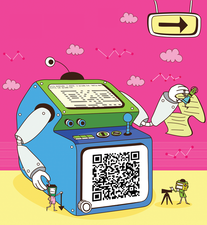Creating and reading QR codes
Simplified

With the right tools, you can create your own QR code squares with information you want to share, for example, on a business card, in a letter, or on your website.
Read errors of unreliable, one-dimensional bar codes often caused interruptions in industrial production, prompting companies like Toyota and its subsidiary Denso Wave to develop as early as 1994 a new code for acquiring stock data. The new matrix bar code was designed to store more information than the traditional bar code and to stay legible, even if the label was dirty, wrinkled, or partially destroyed.
The quick response code, or QR code, comprises a matrix of square dots instead of the usual lines. Measuring up to 177 by 177 dots, the QR code encodes up to 4,296 characters, compared with a bar code that encodes just 13.
Thanks to numerous free reader apps for smartphones, QR codes have gained in popularity in recent years. Posters, catalogs, magazines, business cards, and even television screens display the small squares, offering additional information or URLs for microsites.
[...]
Buy this article as PDF
(incl. VAT)
Buy Linux Magazine
Subscribe to our Linux Newsletters
Find Linux and Open Source Jobs
Subscribe to our ADMIN Newsletters
Support Our Work
Linux Magazine content is made possible with support from readers like you. Please consider contributing when you’ve found an article to be beneficial.

News
-
Parrot OS Switches to KDE Plasma Desktop
Yet another distro is making the move to the KDE Plasma desktop.
-
TUXEDO Announces Gemini 17
TUXEDO Computers has released the fourth generation of its Gemini laptop with plenty of updates.
-
Two New Distros Adopt Enlightenment
MX Moksha and AV Linux 25 join ranks with Bodhi Linux and embrace the Enlightenment desktop.
-
Solus Linux 4.8 Removes Python 2
Solus Linux 4.8 has been released with the latest Linux kernel, updated desktops, and a key removal.
-
Zorin OS 18 Hits over a Million Downloads
If you doubt Linux isn't gaining popularity, you only have to look at Zorin OS's download numbers.
-
TUXEDO Computers Scraps Snapdragon X1E-Based Laptop
Due to issues with a Snapdragon CPU, TUXEDO Computers has cancelled its plans to release a laptop based on this elite hardware.
-
Debian Unleashes Debian Libre Live
Debian Libre Live keeps your machine free of proprietary software.
-
Valve Announces Pending Release of Steam Machine
Shout it to the heavens: Steam Machine, powered by Linux, is set to arrive in 2026.
-
Happy Birthday, ADMIN Magazine!
ADMIN is celebrating its 15th anniversary with issue #90.
-
Another Linux Malware Discovered
Russian hackers use Hyper-V to hide malware within Linux virtual machines.

